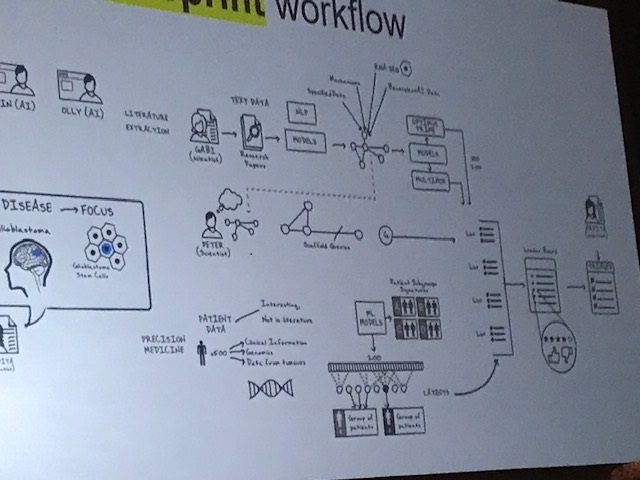BenevolentAI is “a new revolution in drug discovery and development,” according to Joanna Shields, CEO. She shared how their AI platforms are key components in both discovery and development. Their goal is to create treatments to those challenging diseases that have no cure.
“Our mission at Benevolent is to unlock the potential of scientific data, turning it from information that overwhelms us into knowledge that can inspire us.”
Joanna Shields, CEO of BenevolentAI
The number of known diseases in the world is 23,538, but treatments are currently available for only 3% of them. The treatments available took on average $2.5 million dollars and 10-15 years to be made available for the public. Of those being treated, the efficacy rate is 30-50 percent.“We’re failing patients on such a massive level,” said Shields. Part of the challenge is accepting that human biology is too complex to treat one disease with one cure.
“The human body is a product of millions of years of evolution,” Shields explained, “that make each and every one of us a unique individual. If you combine that with the 37 trillion cells that are in the human body, it makes us the most complex data system ever created.” Two people with the same disease and same symptoms in the same part of the body are realistically suffering from two different diseases requiring two different cures.
“AI can help us uncover relationships between diseases and symptoms, drugs and their effect, which patients might respond to a treatment and much more.”
Joanna Shields, CEO of BenevolentAI
Benevolent AI brings scientists across disciplines to tackle the problem from multiple angles. Data scientists wrestle with Big Data and AI modeling, chemists and biologists study the option that AI suggests and pick the best fits, then turn back to the computer scientists to model outcomes with AI before testing on humans.

While it sounds easy, there are a number of moving parts and big issues to wrangle, the first of which is managing all the literature with the human limits of knowledge. 10,000 scientific papers are published a day, along with the millions of patents, chemical databases, clinical trials and other relevant data, it is impossible to keep up. “It’s a wonder that scientists come up with anything at all,” shared Shields.
To help clarify the process, let’s use glioblastoma as a sample case. Glioblastoma is the most common form of brain tumor and almost impossible to treat. This is due to how the cancer uniquely adapts to each patient and the magnificent blocking property of the blood-brain barrier. 98% of all molecules presented do not enter the brain. Lastly, the most malignant part of glioblastoma is the glioblastoma stem cells, which grow the tumor. If even one cell is left behind after tumor removal, it will regrow and continue its deadly course.
“Making drugs that actually penetrate your brain is extremely challenging and that’s why many drugs fail in clinical trials”.
Poojitha Ojamies, biologist at BenevolentAI
Benevolent engages in a process they call a disease sprint, that starts with a hypothesis that predicts the underlying cause of the disease. Then validating the hypothesis through many rounds of AI-assisted experimentation and testing. Once the hypothesis is validated, they design the necessary chemicals and molecules, again with AI assistance, to treat the disease. Once the chemical passes the AI tests, they then seek out the patients that will respond favorably and design a clinical trial.
On the Big Data side, they have two platforms. One manages the known literature and knowledge and updates when new information in released. The other is programmed to identify the gaps between the knowledge, because the gaps are where to find the cure. Interconnectedness between data and all the scientists is vital to finding a cure.
Scientists can input the properties of the chemicals that will work and let AI answer with all possible permutations. At that point the scientists begin constructing a cure. When they have one built, they feed the data back into the patient models to re-predict if it will work. When this process yields what looks to be a functioning model of a cure, then they begin actually building it and testing. Data is constantly fed back into the system and tested for efficacy.
“Our platform allows us to iterate and experiment across many diseases and do this at a previously unmatchable scale and speed. We plan to open up our platform and really challenge the status quo on how drugs are discovered and developed; opening [it] to world-leading researchers, academics, medical charities and partners in industry who can help … make the most of the research and development that we created.”
Joanna Shields, CEO of BenevolentAI

Comments are closed, but trackbacks and pingbacks are open.